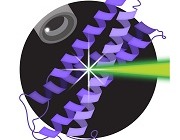In 2016, Pirchi, Tsukanov et al. have introduced "photon-by-photon hidden Markov modeling" (H2MM). This method allows to perform hidden Markov modeling analyses of conformational dynamics in confocal-based single-molecule FRET (smFRET) experiments, photon-by-photon. This has allowed analyzing smFRET conformational dynamics even for dynamics occurring in as fast as a few microseconds!
While H2MM assess conformational dynamics based on a single experimental parameter, the instantaneous donor & acceptor photon rates, better known as the instantaneous FRET value, there are many other experimental parameters that also serve as characteristics of conformational sub-populations in smFRET.
The Lerner lab (Dr. Paul David Harris, a postdoc in the Lerner lab) has recently introduced the multi-parameter H2MM (mpH2MM), which help analyze conformational sub-populations in advanced smFRET experiments (that include more experimentally-derived parameters), where each resolved conformational sub-population is associated with mean values of multiple experimental parameters (e.g., ALEX/PIE-based Stoichiometry, steady-state anisotropies, mean lifetimes). This approach mainly helps in distinguishing between true FRET dynamics (the transition between two sub-populations, where each exhibits different FRET values and each has fluorescently-active donor and acceptor dyes) and dye photophysics (the transitions due to dye bright-dark transitions, which have nothing to do with FRET dynamics, and should be properly decoupled). Read more on this in Harris & Lerner 2021, bioRxiv (under revision).
Please see the available code over GitHub.

|
|
mpH2MM results for DNA hairpin at 300 mM NaCl. a) Burst variance analysis (BVA), the standard deviation of PR values of bursts is displayed versus their PR values. Bursts with standard deviations higher than expected solely from shot noise (semicircle), are ones that include dynamic heterogeneity, such as within-burst FRET dynamics. Triangles indicate the average of standard deviation values per PR bin. b) 2D histogram of PR and SPR (E-S plots, colloquially) of bursts. The PR and SPR values of sub-populations derived from mpH2MM are marked by red circles, and the standard deviation of these values, derived from the Viterbi dwell time analysis, are marked by black crosses. c) Comparison of values of the integrated complete likelihood (ICL) of spH2MM (top panel) and mpH2MM (bottom panel) of optimized models with different state-models. The ideal state-model is marked in red. d) A sample burst trajectory, with photons represented as colored vertical bars, with donor excitation photons colored green or red for donor and acceptor, respectively, and acceptor excitation photons colored purple. PR (top panel) and SPR (bottom panel) of sub-populations determined from dwells using the Viterbi algorithm, are overlayed on the photon bars. e,f) E-S scatter plots of data processed by the Viterbi algorithm. mpH2MM sub-populations and viterbi-derived standard deviations are overlayed as red circles and black crosses, respectively. e,f) E-S scatter plot of bursts (e) or dwells within bursts (f), color coded by which states are present in the bursts (e) or according to the state of the dwell (f), according to Viterbi algorithm. |

